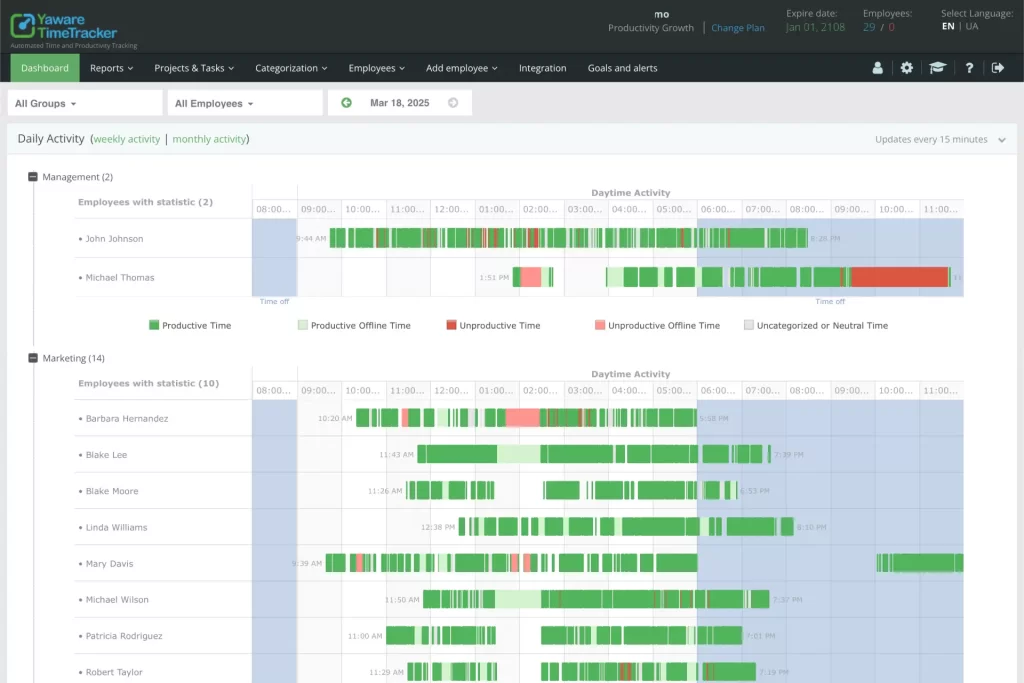Employee burnout has become a critical concern for organizations of all sizes. Research shows that burnout doesn't happen overnight—it's a gradual process that often goes unnoticed until it's too late. By the time an employee submits their resignation, they've likely been experiencing burnout symptoms for months.
The costs of failing to address burnout are substantial: decreased productivity, higher turnover rates, increased healthcare expenses, and damaged team morale. Fortunately, with the right approach and tools, managers can identify the warning signs before reaching the critical point of no return.
Here are five effective ways to detect when your employees are approaching burnout, allowing you to intervene before losing valuable team members.
1. Monitor Changes in Productivity and Work Patterns
One of the earliest and most reliable indicators of impending burnout is a shift in work patterns and output quality. These changes rarely happen dramatically—they typically emerge as subtle variations that time tracking tools can help identify.
When employees who consistently delivered high-quality work begin missing deadlines or submitting work requiring extensive revisions, it's often a red flag. Similarly, unusual working hours—such as timestamp patterns showing late-night work sessions followed by inactivity during regular hours—can indicate an employee struggling to keep up.
Time tracking solutions like Yaware TimeTracker can automatically detect these changing patterns by analyzing productivity trends over time. The system can alert managers when an employee's productivity fluctuates significantly from their baseline, providing an early opportunity for intervention.

💡 Pro Tip: Set up automated alerts for when an employee's productivity drops by 15% or more from their three-month average. This threshold typically indicates a meaningful change worth investigating rather than normal day-to-day variation.
2. Track Overtime and After-Hours Work
Excessive overtime is a reliable predictor of approaching burnout. When employees consistently work beyond regular hours without adequate recovery time, their risk for burnout increases dramatically.
Modern time tracking systems can monitor not just when employees are working but how their work hours are distributed. An employee regularly logging in during weekends or responding to emails at midnight is demonstrating behavior strongly correlated with eventual burnout.
Yaware TimeTracker's after-hours work reports allow managers to identify team members who may be taking on unsustainable workloads. The system can distinguish between occasional crunch periods (which are normal in many industries) and problematic long-term patterns that lead to exhaustion.
3. Analyze Communication Patterns and Response Times
Changes in communication style and responsiveness often precede burnout. An employee who previously responded promptly to messages but now takes hours or days to reply may be experiencing emotional exhaustion—a core component of burnout.
Digital communication metadata can reveal important trends: Are emails being sent at increasingly late hours? Has participation in team chats decreased? Are response times growing longer? These metrics, when viewed collectively, provide valuable insights into an employee's engagement and energy levels.
Time tracking platforms with communication analytics can quantify these changes, helping managers distinguish between an employee who's simply busy with productive work versus one who's struggling to maintain their normal communication cadence due to burnout.
4. Measure Task Completion Velocity
The speed at which employees complete tasks often changes as they approach burnout. This shift can manifest in two ways: some employees slow down dramatically as their mental energy depletes, while others paradoxically speed up but with declining quality as they try to “push through” their exhaustion.
By tracking task duration and completion rates over time, managers can identify concerning trends. A previously efficient employee who now takes twice as long to complete routine tasks may be experiencing concentration difficulties—a common burnout symptom.
Yaware's task tracking functionality enables managers to monitor these metrics without adding reporting burden to the team. The system automatically calculates average completion times for similar tasks, flagging significant deviations that might indicate an employee is struggling.
5. Monitor Work-Life Balance Indicators
Perhaps the most important burnout predictor is deterioration in work-life balance. When the boundaries between professional and personal time begin to blur, burnout risk increases substantially.
Key indicators include: vacation time going unused, lunch breaks becoming shorter or nonexistent, and start/end times gradually extending. Time tracking data can reveal whether employees are taking appropriate breaks or if they're working continuously without recovery periods.
Yaware TimeTracker provides specialized reports highlighting work-life balance metrics across teams, allowing organizations to address problematic patterns before they lead to burnout. The platform can also track vacation usage and encourage regular breaks through gentle notifications.
💡 Pro Tip: Create a “recovery ratio” for your team by dividing non-work hours by work hours each week. Research suggests maintaining at least a 3:1 ratio (three hours of rest/personal time for each hour worked) significantly reduces burnout risk. Use this as a team benchmark rather than an individual monitoring tool to respect privacy.
Taking Action Before It's Too Late
Detecting potential burnout is only valuable if it leads to meaningful intervention. When warning signs appear, managers should initiate supportive conversations, reassess workloads, and consider temporary adjustments to help employees recover.
Time tracking tools like Yaware TimeTracker provide the data needed to have these conversations based on objective information rather than assumptions. This approach transforms time tracking from a mere productivity tool into a crucial component of employee well-being programs.
By implementing these detection methods, organizations can create healthier work environments where burnout becomes the exception rather than an accepted part of corporate culture. The investment in prevention pays dividends through improved retention, sustained productivity, and stronger team morale.

